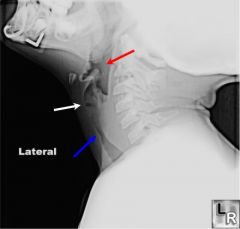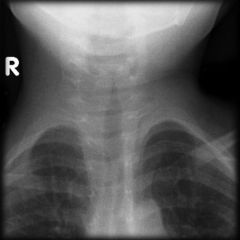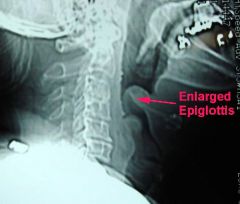![]()
![]()
![]()
Use LEFT and RIGHT arrow keys to navigate between flashcards;
Use UP and DOWN arrow keys to flip the card;
H to show hint;
A reads text to speech;
31 Cards in this Set
- Front
- Back
|
What is the etiology of croup?
|
Viral- primarily caused by parainfluenza type 1 (60%) cases.
|
|
|
When a patient presents with croup, what occurs within their airway?
|
Luminal narrowing, airway edema, causing stridor, hoarseness and cough.
|
|
|
What percentage of patients will be hospitalized due to croup?
|
20-30%
|
|
|
What percentage of those hospitalized for croup will need to be intubated?
|
>1%
|
|
|
What is the most common patient population that contracts croup?
|
Toddlers- between the ages of 6 months and 3 years old with greatest incidence during 2nd year of life.
|
|
|
How is croup transmitted?
|
droplet
|
|
|
At what season is croup most prevalent?
|
fall/early winter
|
|
|
Does croup occur more often in males or females?
|
males- 2:1
|
|
|
What is the prodrome of croup?
|
Coryza, nasal congestion, sore throat, cough, progressive fever.
|
|
|
When is croup most active?
|
At night time
|
|

What clinical manifestation of croup is seen on this x-ray?
|
subglottic narrowing
|
|

What clinical manifestation of croup is seen on this x-ray?
|
steeple sign
|
|
|
What are the DDx of croup?
|
Bacterial tracheitis (adults), retropharyngeal abscess, diptheria (rare), vascular ring (stridor), epiglottitis, peritonsillar abscess, laryngomalica, aspiration, inhalation injury
|
|
|
What is the treatment for croup?
|
Cool mist (parental treatment), nebulized epinepherine (to avoid intubation), corticosteroids, entrotracheal intubation (when airway abstructed)
|
|
|
What is the dosage for dexamethosone that should be given for a child with croup?
|
0.6 mg/kg-- given to decrease swelling and avoid intubation.
|
|
|
How should a mild case of croup be treated?
|
Mild = barking cough W/O stridor. Fluids and rest.
|
|
|
How long should you observe a patient before deciding to admit them for croup?
|
3-4 hours.
|
|
|
What is the treatment for a severe case of croup?
|
Severe = barking cough with stridor. Patient will present with tripod postition and drooling. Patient should be hospitalized, and given epi. Intubated if necessary (AVOID). Blood gas should be taken to monitor resp. distress
|
|
|
What are some complications of croup?
|
Bacterial tracheitis- due to staph, haemophilus, flu, or strep, m. cat-- mimics epiglottitis
|
|
|
What is the etiology of epiglottitis?
|
H flu group B for bacterial cases and parinfluenza B for viral cases.
|
|
|
Is epiglottitis a gradual progressing disease or does it have an acute onset?
|
Acute onset- rapid spread of infection.
|
|
|
Is epiglottitis considered to be an emergent situation?
|
Yes- airway emergency!
|
|
|
What position are those found with epiglottitis usually in?
|
Sniffing dog
|
|
|
Why has the prevalence of epiglottitis decreased in the past 20 years?
|
Hib vaccine
|
|
|
What age group normally has a high incidence of epiglottitis?
|
Children ages 2-7, but can occur at any age.
|
|
|
What are the signs and symptoms of epiglottitis?
|
abrupt onset of high fever (102+), toxic appearance, respiratory distress, stridor, inability to swallow, cyanosis (possible)
|
|
|
How is the dx of epiglottitis made?
|
Physical exam- swollen red epiglottis. Head x-ray reveals "thumb sign". Culture of the epiglottis and blood test to uncover specific cause. Immuno testing.
|
|

What clinical manifestation of epiglottitis can be seen on this x-ray?
|
Thumb sign- swollen epiglottis
|
|
|
What are the ddx for epiglottitis?
|
bacteiral tracheitits, croup, retropharyngeal abscess, foreign body aspiration, diptheria, mono, burn on airway, trauma, laryngomalacia, severe pharyngitis
|
|
|
What is the treatment for epiglottitis?
|
Ventillary support, intravenous antibiotics (2nd/3rd cephalosporins)
|
|
|
What is the prognosis for epiglottitis?
|
Sequelae may include sepsis and shock, pneumothorax, tracheal stenosis, cerebral anoxic injury, death. Moratlity can be up to 10% (cyanosis = poor prognosis)
|

